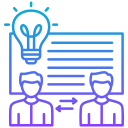Boosting Problem-Solving Abilities with Peer Programming
Unlock the full potential of software development by leveraging the collaborative approach of peer programming. This dynamic methodology brings programmers together to solve complex problems, share knowledge, and produce high-quality code. By working in pairs, developers are exposed to new perspectives, innovative solutions, and immediate feedback, all of which contribute to increased problem-solving abilities. Throughout this page, explore how peer programming drives analytical thinking, enhances code quality, and cultivates technical communication—all essential elements for transforming challenges into opportunities for growth and innovation.

The Power of Collaborative Thinking
Diverse Perspectives in Action
Peer programming pairs developers with different backgrounds, skills, and levels of expertise. Such diversity ensures that each participant views challenges from a unique vantage point. This blend of perspectives generates more creative and comprehensive solutions than what is possible alone. For instance, one partner might excel in algorithm optimization, while the other shines in code architecture, resulting in well-rounded outcomes that neither could achieve independently.
Real-Time Feedback and Adaptation
Working side-by-side generates immediate opportunities for feedback. As one peer writes code, the other can quickly spot errors, suggest modifications, and introduce alternative ideas. This instant exchange eliminates the lag time associated with code reviews and fosters a habit of catching mistakes early. The continuous loop of writing and reviewing strengthens analytical thinking, as partners must justify their choices and adapt to critiques in real time.
Turning Individual Weaknesses into Team Strengths
Peer programming transforms individual limitations into collective assets. When a blocker arises, one partner’s strength can overcome the other’s weakness. This sharing and reinforcement of knowledge not only accelerates problem resolution but also facilitates direct skill transfer. Over time, both participants expand their toolkits, becoming more adaptable and resourceful developers.
Deepening Understanding through Discussion
Collaboration requires verbalizing complex concepts and rationalizing decisions. Explaining one’s thought process deepens understanding—not only for the speaker but also for the listener, who may challenge or refine those ideas. Repeatedly breaking down and reconstructing technical challenges cultivates clarity, precision, and a keen analytical mind.
Continuous Learning and Skill Development
Participation in peer programming naturally drives skill acquisition. Each session serves as a micro-workshop where developers encounter new techniques, programming paradigms, or tools firsthand. This active learning environment accelerates growth, as partners introduce each other to shortcuts, coding standards, and problem-solving frameworks that might otherwise remain undiscovered.
Building Communication and Technical Articulation
Bridging the Gap between Ideas and Implementation
Translating abstract ideas into actionable code requires clear articulation. Peer programming gives developers constant practice in bridging this gap, requiring thoughts to be laid bare for examination and execution. This translation from concept to code sharpens communication skills and ensures that solutions are not only effective but also understandable and reproducible.


Constructive Critique and Collaborative Growth
Mutual critique is a staple of the peer programming process. By offering and receiving feedback in a professional setting, developers learn to appreciate constructive criticism and harness it for improvement. These social interactions build trust, temper egos, and foster a safe environment where creativity thrives, all of which are essential for developing pragmatic and innovative solutions.
